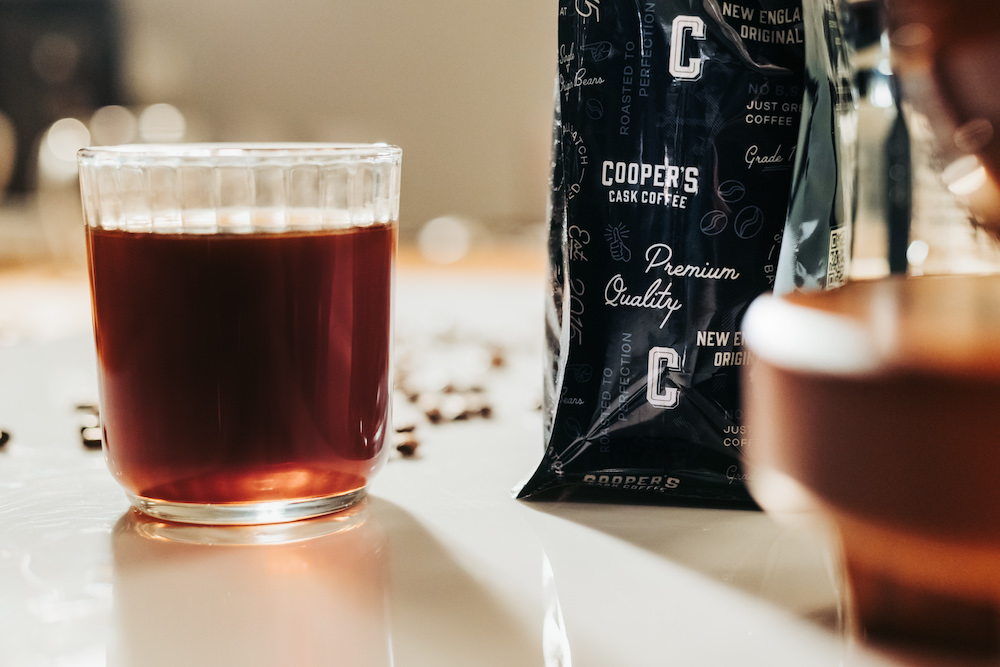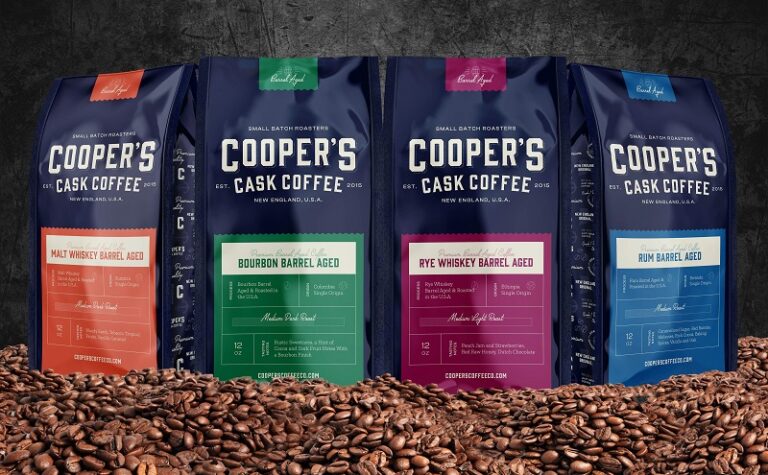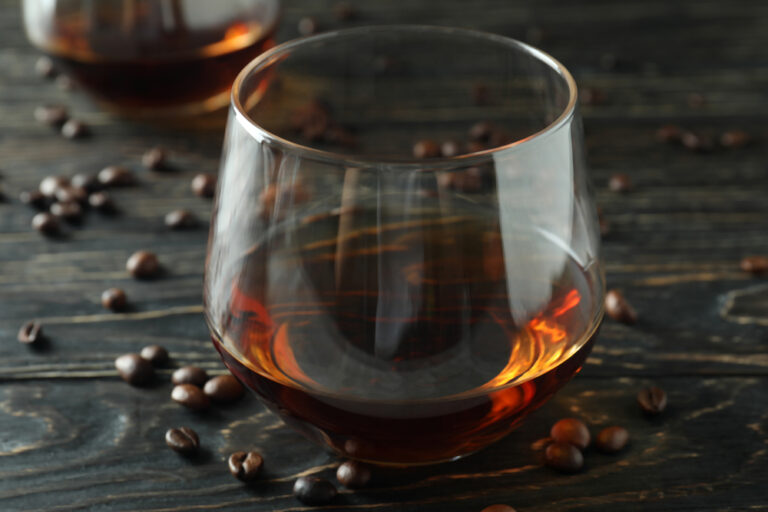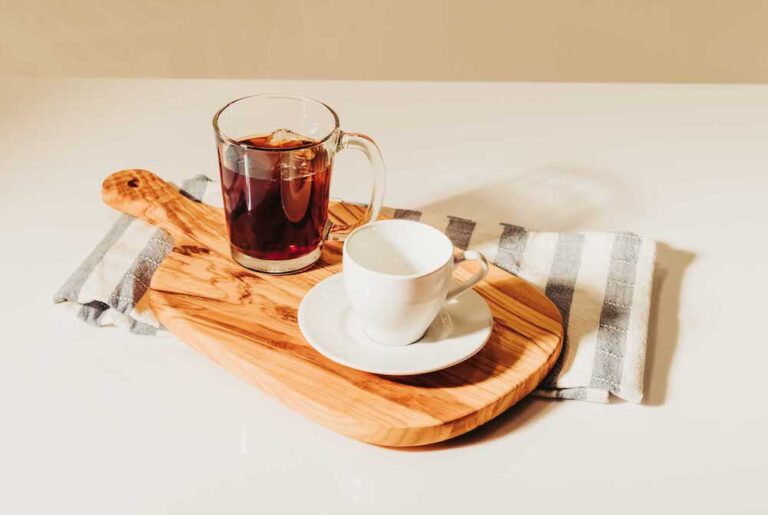Beauty may be in the eye of the beholder, but flavor is in the mouth of the cup holder.
Cooper’s Cask Coffee has a wide selection of single origin coffees and specialty barrel aged coffees. They’ve earned over 6000 4- and 5-star reviews on Amazon for their great taste and freshness.
Even with the best product, that doesn’t mean you can’t make a bad cup of coffee! Obviously, those reviews mean we’re doing something right. But what goes into making the perfect cup of Cooper’s? Read on for your guide to a great coffee experience.
The Perfect Cup Begins With Water
Because a cup of coffee is 98 to 99 percent water, this liquid can make or break a cup of joe. Water is the key to extracting coffee’s soluble flavor compounds that create a flavor profile.
For example, our Kenya AA Medium Dark Roast Coffee has a flavor profile that includes tastes of baked peaches with a heavy syrupy body. These flavors can be altered by the quality of the water that does the extraction. If it’s good-quality, the water helps deliver a balanced profile. If it’s poor-quality, the water can negatively affect both the aroma and flavor in your cup.
How Do You Determine Water Quality?
Most households use tap water in their coffee maker to brew up a pot. The hardness of that water is the first determining factor. Here’s why: high calcium/magnesium hard water alters the extraction and ends up brewing a bitter cup.
The calcium clings to the flavor components that make things taste bitter, so if there’s high calcium content in the water, it extracts more bitterness.
Conversely, if the water is “softened,” it has a lot of the calcium and magnesium taken out of it — but now there’s more sodium in it. Sodium-rich water means less flavor and less caffeine. The cup ends up tasting lackluster and flat, or if the ground coffee is low in acidity—it can give the cup a sour flavor.
So what are we looking for?
We’re getting into some science here, but you were looking for how to make the best cup of coffee!
We want a middle ground of hardness vs softness. We find that by measuring the pH balance of the water. The best brewing uses water with a pH level around 7. That’s a great middle ground between being hard (alkaline) and soft (acidic).
You can find battery-operated pH meters on Amazon.com. And if you need to, you can raise or lower the pH balance of your brewing water in several ways:
- Add sodium bicarbonate (baking soda) to increase the alkaline level.
- Add lemon juice to increase the acidity level.
- Use a specialized filter system.
Water filter systems exist to change the pH of your tap water, ranging from hand-held pitchers to water system additions.Test your water first to see where the pH balance is, and if necessary adjust from there.
Start with Fresh & Cold Water
You’ve tested it, tasted it, and you know the kind of water you want, plus how to get it. As you get ready to fill your coffee maker, your french press carafe, or your pour-over drip kettle, don’t use hot water in the beginning.
Fresh, cold water is always your best starting point for brewing coffee. Even if you have in-system pH balancing filtration, hot tap water is water that sits in a tank for what may be hours, or days, depending on usage. The longer it’s unused, the better chance bacteria can grow, causing sulfurous or rotten egg odors, which does nothing for your coffee aroma to say the least.
Also, if you notice a slightly metal taste—it could be corrosion caused by the scaling inside the water heater. As hard water sits in your water heater, the heat can cause the water to gasify (steam), and escape. What’s left is even more alkaline, and because there’s so many concentrated minerals in the water, they begin to settle at the bottom of the tank, causing corrosion.
You may want to save time for your french press by using hot water to fill your drip kettle. But as you can see, that minute or two you save could mean missing the best cup of coffee you can make.
Other Reasons to Filter Your Coffee Water
As you’re learning how to make the perfect cup of coffee, there are other water source issues that can put the flavor off in your coffee:
- Soil substances, both organic and mineral
- Water treatment additives (chlorine, fluoride, etc)
- Water supply system materials (copper, iron)
- Pollution residues getting into drink water supplies
- Microbes in the supply system (“lake” smell/odor, etc)
Related topic: how to store coffee beans
The Best Temperature for Brewing
Filtered, pH balanced, fresh and cool water is ready to be heated. So how hot should you make it?
The answer matters, because water temperature impacts extraction—the part of the brewing process that makes coffee grounds into coffee. Extraction is how the tasty, aromatic solubles from the grounds are pulled into the water.
According to the National Coffee Association, if you want your water to perform the best extraction, it needs to be 195°F to 205°F—so not boiling, but almost. This peak temperature range works for all coffee brewing methods.
The higher above 205°F you go, the more extraction you get from the coffee grounds. This can cause too much extraction, resulting in a bitter cup. On the other hand, if the water’s below 195°F, you can end up with a sour and/or underdeveloped brew.
Of course, there is a slight caveat: depending on the roast you’re brewing, getting the best taste may require raising or lowering the water’s temperature.
If you’re using a lighter roast, you might brew your coffee at a slightly higher temperature. This will facilitate improved extraction for more flavor. A darker roast might benefit from a lower temperature, so that you don’t over-extract the grounds and end up with a harsh experience.
Measuring the Temperature
Yes, it’s really that obvious: a thermometer is your best friend for getting your water to the right temperature.
A traditional kitchen thermometer is always reliable. However, if you like cool tech, a high-end infrared laser thermometer allows you to measure temperatures from a distance.
Other methods of getting the right temperature include:
Boil-and-Wait
Let’s say you’re making French press. Heat your water to boiling—then turn off the heat source and let it set for a minute. That bit of resting time allows the water to get down to the 205°F range.
Dial-and-Done
Higher-end heating kettles have custom settings for the right brew temperature. Depending on the model, you may have to use your thermometer to test settings for the right heat target. But once you know where to crank the dial, it’s nothing but great brewing from then on out.
Buy-the-Best
That cheap coffee maker from the big box store? No matter how much great-grandma loves hers, if you want to make the best cup of coffee, you’ll need to up your price tag for the best type of drip coffee maker.
One way to make sure your coffee maker is top notch is to hit up our Cooper’s Cask Coffee Gear page and check out the Moccamaster KBGT. Not only does it brew at the right temperature, it dispenses your “pot” of coffee into a stainless steel carafe with a borosilicate glass lining. It retains heat longer, and doesn’t “burn” your brewed coffee by constantly cooking it over a heating element.
How to Make the Perfect Cup of Coffee: Now for the Grind
The size of your grind affects the rate of extraction. It’s not a one-size-flavors-all situation. The smaller the grind, the more surface area of the roasted beans come into contact with the water. Also, with a smaller grind, the water takes longer to pass through, which adds to the extraction power.
These Machines Are Groundbreaking
Buying whole coffee beans keeps your coffee fresher, longer. But you’ve got to grind it before you can get that delicious flavor into the cup.
When looking for a coffee grinder, there are 2 kinds—and we only recommend 1 of them.
Blade Grinders for Coffee
This type of grinder is commonly found in households. They’re easy to purchase, since most big box stores carry them. You’ll also generally find coffee blade grinders at lower price points.
Blade grinders work much like a blender. At the bottom of their bean hopper—the place where you load your coffee beans—is a spinning blade. This blade chops up the beans.
We don’t recommend blade grinders. Sure, they can be easier on the wallet. However, they do a less-than-admirable job of creating the ground size you need for your style of brewing.
Because you can’t set a ground size, and due to the fact that the beans have to bounce around to get chopped, the final ground coffee comes in uneven particle sizes. Sometimes those particles can be almost an entire bean, if during the bouncing and chopping process the bean was able to lodge out of reach of the blade.
Another issue with blade grinders is heat. If you’ve ever felt the grounds after using a blade grinder, they can be surprisingly warm. The blade grinding process generates heat as it chops. That heat can damage your coffee particles, further lowering the quality of the final brew.
This uneven (and possibly heat-damaged) grind is not how to make the perfect cup of coffee. The tiniest particles will be over-extracted and give the coffee a bitter tang, while the too-large chunks won’t provide enough flavor. You’ll end up with a cup of sub-par coffee that’s drinkable, but not amazing.
Burr Grinders
We recommend a burr grinder to achieve your best tasting coffee.
Burr grinders grind by pressure rather than by chopping. Your burr grinder—also called a “mill grinder”—crushes the coffee beans between two textured discs called burrs. The amount of space between the discs can be increased or decreased, creating larger or smaller coffee bean particles.
Creating grounds this way produces more uniform particles, because the space between the burrs determines grind size. You won’t end up with those monster chunks, plus you’ll have fewer “fines”—those powder-like coffee grounds.
Burr grinders come in 3 different operational styles:
- Manual grinder. Resembles a hand-cranked pepper mill.
- Electric flat burr grinder. Adjustable and used both in home and commercial settings.
- Electric conical burr grinder. Quieter, and most popular for home use.
Burr grinders provide accuracy and multiple choices for grind level; so that you get the perfect ground to make espresso, or perc a pot in your old-school percolator. Blade grinders just chop, and what you get is what you get. It could be worse, but if you can swing a burr grinder, it can be much, much better.
Our Burr Grinders
Cooper’s Cask Coffee has several burr grinders to choose from on our Gear pages.
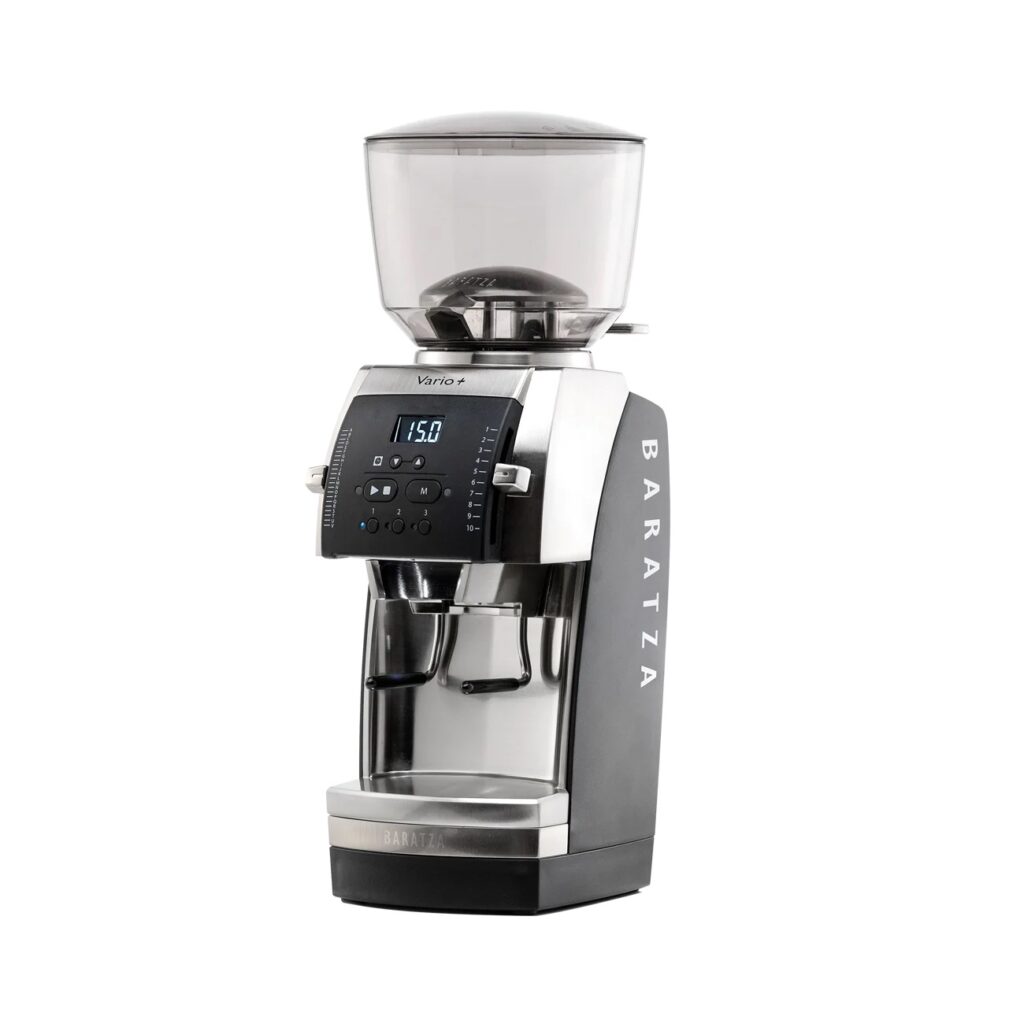
Baratza Vario+
With over 220 easy-to-do steps of adjustment, this top-end grinder will ensure the just-right grind size.
Another cool feature is the adjustable dosing time. This works great for coffee lovers who measure the weight of the coffee along with grind size. These aficionados know how long it takes to grind a certain weight of coffee. The Vario+ allows you to set the length of time for grinding to achieve the right weight of coffee, and will remember your 3 favorite dose presets.
The durable construction of the Baratza Vario+ includes an all-metal portafilter holder for espresso making.
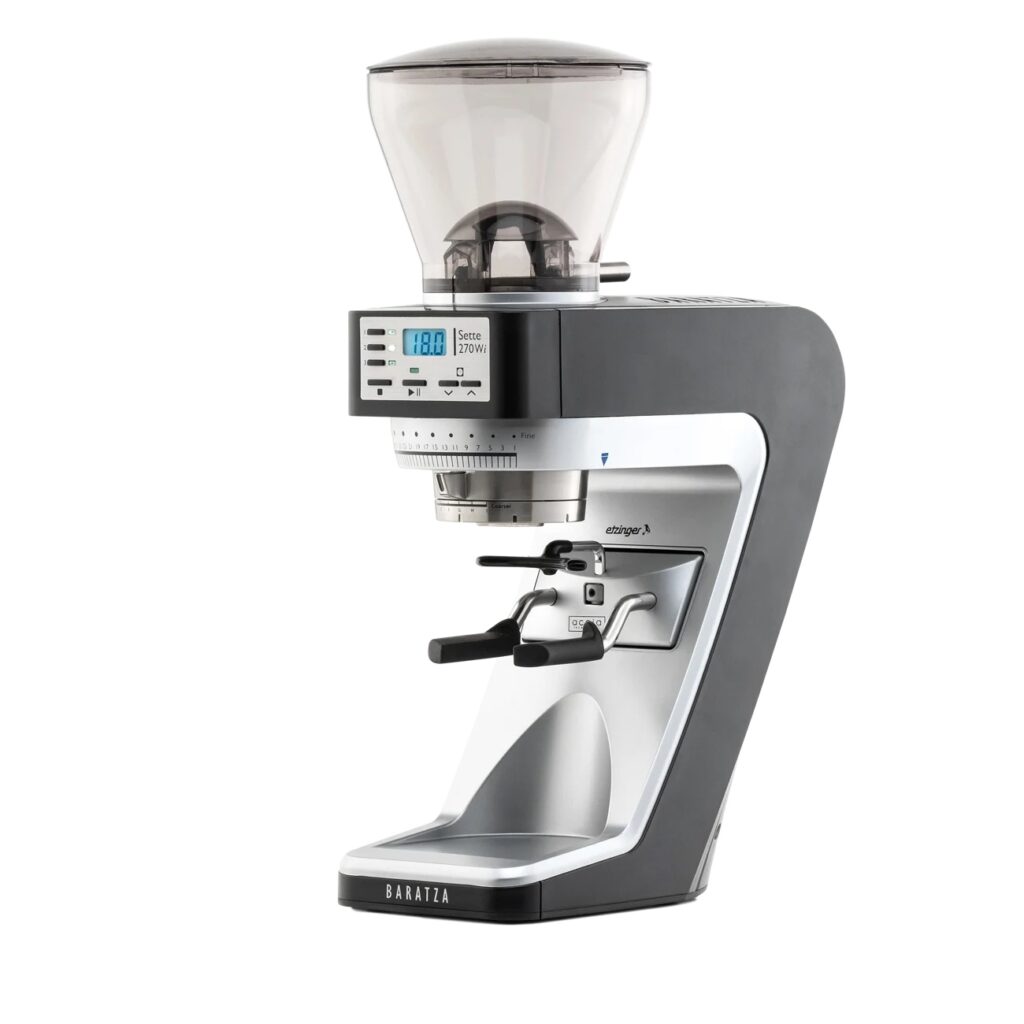
Baratza Sette 270Wi
Take your grinding game to the next level with the Baratza Sette 270Wi.
The revolutionary gearbox and burr set design provide fast grinding and minimal waste. You can set the grind size with an integrated adjustment assembly offering you 30 macro steps of adjustment, plus 9 marked settings of stepless micro-adjustment for responsive grind setting changes. With this burr grinder you can truly “dial in” on the perfect grind size!
Dosage is calculated and controlled automatically by a precise digital scale utilizing Acaia weighing technology. Just set it for the weight you want, and start grinding.
The i in Wi stands for “intelligent.” The Baratza Sette 270Wi calculates and self-adjusts after you make changes in coffee bean or grind size. It also includes Bluetooth connectivity so that you can pair your Sette 270Wi with Acaia’s Sette Updater app on iOS. This way you can always be up-to-date on the operation software.
These are just 2 of the 8 coffee burr grinders we offer on our website! Check out the selection and price points to find the just-right one for you. If you feel a little overwhelmed by the different abilities each grinder offers, contact us for burr grinder recommendations. We’ll be happy to help you discover the right grinder for your lifestyle and flavor preferences.
Let’s Find Your Grind
How do you choose the grind size? Start with this basic chart for which grind size is generally chosen for certain brewing styles. How you like your coffee to taste is determined by your own palate; however, this will give you “common grounds” to making the perfect cup of coffee.
| GRIND | SIZE LOOKS SIMILAR TO: | BREWING STYLE |
| Very coarse | Rock salt | Cold brew |
| Coarse | Coarse sea salt | French press, percolator |
| Medium-coarse | Rough sand | Chemex |
| Medium | Cone-shaped pour-over, flat-bottom drip coffeemakers | |
| Medium-fine | Smooth sand | Cone-shaped pour-over, AeroPress (3 min) |
| Fine | Table salt | Espresso, AeroPress (1 min) |
| Extra fine | Almost powder-like | Turkish |
Cooper’s Cask Coffee offers multiple grind levels along with whole bean coffee, so you can enjoy it however you like. It also allows you to experiment by allowing you to control each variable of the brew process.
Related topic: why fresh coffee beans make all the difference.
How Coffee Filters Affect Coffee Flavor
If you use a coffee filter in your brewing process, you’ll need the right filter to keep you from drinking grit or gravel.
The coffee filter you choose will not only keep the grounds mostly out of your coffee; it can also alter the flavor you get in your pot or cup.
There are two types of coffee filters: paper coffee filters and screen coffee filters.
Paper Coffee Filters
Paper coffee filters come in either bleached (white) or unbleached (tan/brown) versions. There isn’t a noticeable difference in the taste delivery between the two. They have a variety of shapes and sizes to suit a large number of brewing styles.
A paper filter affects the flavor of your brew through the filter’s absorption of coffee oils. These “diterpenes” are part of the bold flavor of coffee and the richer mouth-feel.
Paper filters soak up these oils, giving your cup a lighter and “cleaner” taste. They also provide the maximum filtration of particulates (coffee grounds).
Clean-up is easier with paper coffee filters, as they’re a single-use item that is either tossed or recycled with grounds for things like compost. Cooper’s Cask Coffee carries paper filters for AeroPress coffee makers, and paper filters for the Hario V60 pour over coffee maker.
Metal Coffee Filters
Metal coffee filters come in flat-bottom or cone shapes. The cone shapes include a plastic-reinforced cone with a handle, or as a full-circumference mesh screen.
When you use a metal coffee filter, you’ll get all the oils that come with the bean and the roast. This can provide a more complex, richer flavor with sometimes sweet overtones. It also increases the mouthfeel of the coffee.
The drawbacks include more of the extremely fine particulates (“fines”) getting through the filter, and the need for cleaning of the filter.
How to Make the Perfect Cup of Coffee: Pick Your Brew
You’ve got the right water, the right grind size, the right filter, and the right single origin coffee. Now it’s time to pick your brew style, and start enjoying your perfect cup!
Brew styles differ on how involved you want to be in the brewing process and how much time you have. Some are hands-on (such as pour-over), some involve moderate manual effort (AeroPress), and some just involve adding water and coffee to the auto-drip coffee maker and pressing a button.
Your palate dictates your method. Make the coffee that makes you happy!
Auto-Drip Coffee Maker
These coffee makers are the most common you see in households. They can be as simple as pouring in the water, the coffee grounds, and clicking a button. They move up from there in complexity, including timers for automatically starting the brew at specific times, and even the inclusion of a built-in grinder for automatically created grounds.
These coffee makers heat the water to boiling, which forces the hot water up a tube to dispense over the coffee grounds via a special head. The water works through the grounds until they’re saturated, extracting the coffee and then passing through the filter and into your cup or pot.
Percolator Coffee Maker
A percolator coffee maker works on the same basic principle as an auto-drip coffee maker. Water is placed in the percolator’s chamber, and when heated to boiling, it flows up a tube, disperses over a drip top, and drips through that onto the coffee grounds held in the percolator’s perforated basket.
That is where the similarity ends.
Because a percolator has a single chamber, the original water flows up through the tube, over the coffee grounds—and the brewed coffee drips down into the water again. In essence, a percolator is re-brewing coffee over and over. This pulls out more acids, bitter compounds, and oils than other processes, running the considerable risk of over-extraction and a bitter brew.
You’re also boiling your already-brewed coffee. A percolator requires the water to be at boiling (212°F), which is well above the optimum extraction range. Any delicacy or subtleties in the flavor of your coffee is erased by this over-extraction.
Now, to show the percolator method at least a little love—if you keep an eye on it, it does deliver a very rich, full coffee experience.
Espresso
An espresso machine works by high pressure to force hot water through a packed “puck” of finely ground coffee. The pressure is created by either heating (steam) or mechanical measures (pistons or pumps).
An espresso machine uses a smaller amount of water to create the cup. The water is heated to boiling/steam and forced through the coffee grounds instead of being dripped on them. This process extracts much of the oils and flavor from the fine grounds, giving espresso its distinctive thick consistency and powerful flavor.
Cooper’s Cask Coffee offers espresso coffees that make a great cup.
French Press
When using a French press, you add your coarse coffee grounds into a glass beaker or carafe. Using an electric drip kettle or other device, heat your water to the proper temperature and pour it on top of it. You let the coffee steep for a certain amount of time—the longer it steeps, the more the extraction.
Once the steeping time is done, you’ll use the plunger connected to the top of the French press to force a metal mesh filter down to the bottom of the beaker. This separates the coffee grounds from the liquid coffee, and you can pour your coffee from there.
French press coffee makers come in several sizes, from single cup up to multi-cup. However, you won’t find them in larger volume sizes because of the pressure used to force the coffee grounds to the bottom of the beaker.
AeroPress
Similar to a French press coffee maker, an AeroPress uses manually created pressure to create the coffee. However, the plunger action works completely differently.
In an AeroPress maker, you put your small, round paper filter in the AeroPress’s cap, and screw that onto the bottom. Then you add your medium-fine to fine coffee grounds into the chamber, pour in hot water, and let it steep for 1 to 3 minutes depending on the grind chosen.
When the steeping time is done, you insert an air-tight plunger into the top of the chamber and slowly push down. The plunger creates air pressure, which forces the brewed coffee down through the filter and into your cup. This also extracts a little more flavor from the grinds for a good, rich taste.
A popular choice, the AeroPress also comes in an AeroPress Go Travel Coffee Maker so that you can enjoy great coffee practically anywhere.
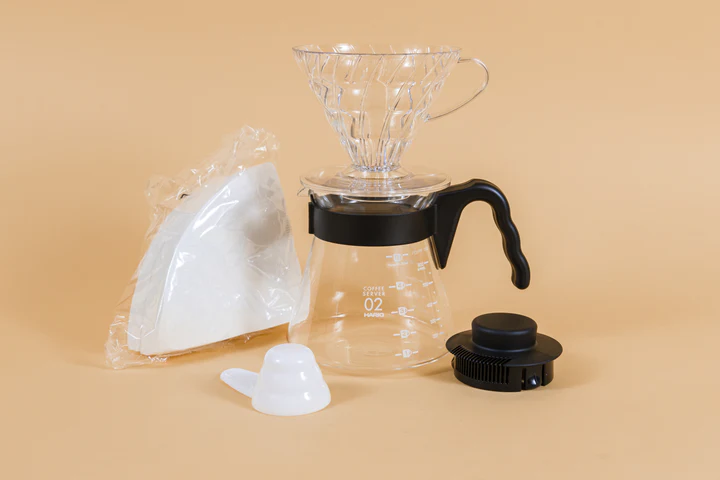
Pour Over
Our favorite way to make coffee here at Cooper’s Cask Coffee, the pour over brewing method is totally manual, and extremely delicious. The pour over lets you control the results, from extraction heat to filter to grind size. Using a special pour over cone, you put in your filter and coffee, then place the cone on top of your cup or pot. Using your drip kettle, you slow pour hot water in a spiral pattern over the grounds.
We’re not ashamed to say what drips through is pure heaven. With our Hario Outdoor Pour Over Set, you have all you need to create amazing pour over coffee wherever you can heat the water. This sturdy set is great for campouts, tailgating, and picnics.
For all of these brewing styles, Cooper’s Cask Coffee can help you discover the best coffee for your desires. Try out our free online coffee finder tool to sleuth your way to a superior sip.
Now You Know How to Make the Perfect Cup of Coffee
The hardest part is deciding how involved you want to be in the brew process. Many of our customers have purchased our automatic machines for speedy coffee pleasure, but have also purchased our manual equipment for times when they can just relax and enjoy the process, from opening the bag on the freshest coffee beans to those wafting brewing aromas and finally—to that first delicious sip.
Your taste buds will tell you what works. We’re here to help them speak your best coffee language.
Cooper’s Cask Coffee for Perfect Coffee Pleasure
Not to brag (but we’re going to), we have over 7000 4- and 5-star reviews on Amazon. Our barrel aged coffees intensify and heighten taste profiles. The fact that we use single origin coffees provides unique, authentic coffee notes and flavors from around the world.
You receive the freshest roasted beans, with the roaster’s hand-written roast date and coffee batch on every bag. Whether you just like trying different coffees, or you’re a total coffee snob, we make sure our small batch coffee delivers big satisfaction.
Cooper’s Cask Coffee. Coffee the way it should be.
Sign up for our email list and get 10% off your first order!
